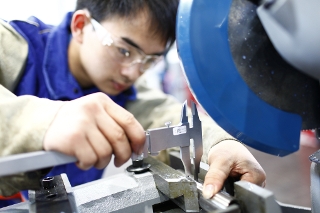Construction Metal Work
Skill Explained
Construction metalworking involves the skills required to mark out, cut and assemble, repair and maintain steel structures such as buildings, bridges, heavy plant and lifting equipment. A construction metalworker must have a good knowledge of mathematical calculations and geometrical techniques, and be able to interpret simple and complex engineering drawings. He or she must be able to fabricate small to large structures and check them for correct dimensions, square, parallel and flatness.
A construction sheet metalworker must be capable of applying the above skills to a range of steels including low carbon, stainless, alloy steels and aluminium alloys. He or she must also have a comprehensive knowledge of a range of industrial cutting and forming processes to suit these materials.
Construction metal workers can work within an engineering workshop for cutting, fabricating, assembling and joining / welding of heavy to light steel structures. Construction metalworkers can also work out on site as required in positioning and fixing fabricated steel structures.
Construction metalworkers interpret engineering and construction drawings to lay out, cut, shape and accurately assemble light to heavy metal sections and light and heavy sheet/plate into structures such as crane jibs, bulldozer buckets, crane runaways, and steel substructures for roofs, buildings and halls.
A construction metalworker uses a range of cutting and shaping tools and equipment to prepare sections for assembly. He or she uses a variety of standard welding processes to assemble and join these materials into structures and products.
Construction metalwork serves industries that include dairy, pharmaceutical and chemical industries, and civil engineering projects that may involve steel structures for buildings, bridges or lifting equipment.
What the Competitors do at the Competition
The Competitor has to make a simple structure with material as defined in in the test project in accordance with detailed drawings, using the appropriate machines, tools and techniques.
The Competitor will be judged on the following:
- Working Environment
- Marking out techniques
- Cutting techniques
- Forming techniques
- Assembly techniques
- Welding and joining techniques
- Finishing techniques
Competitors
Young Jun Bae
Korea
David Damasceno
Brazil
Florian FRETAULT
France
Christopher Hanson
United Kingdom
Michael James
Australia
Dean McSweeney
Ireland
Andreas Neuenschwander
Switzerland
Timo Paananen
Finland
Martin Schwaiger
Austria
Shoki Yasuda
Japan
Jiacai Zeng
China
Experts

Rafael Borges
Brazil

Woong Eui Choi
Korea

Tatu Hirvonen
Finland

Jérémie Jury
France

Dezhi Ma
China

Craig McVittie
Australia

Roger Müller
Switzerland

Helmut Muralter
Austria

Mikio Nozawa
Japan

Tim O'Halloran
Ireland

Andrew Whitehouse
United Kingdom

SHANG-PANG YU
Chinese Taipei
Videos
A New Look at Skills
Autodesk Publisher 3D models*
Download for desktop
Download for mobile
Autodesk Inventor Data Sets**
* Open the 3D models on desktop with Autodesk Inventor Publisher. On mobile download the Autodesk Inventor Publisher Mobile Viewer app (iOS or Android).
** Students and Teachers can download Autodesk Inventor software via the Autodesk Student Community, Educational Institutions via Autodesk Academic Resource Centre (ARC).






























